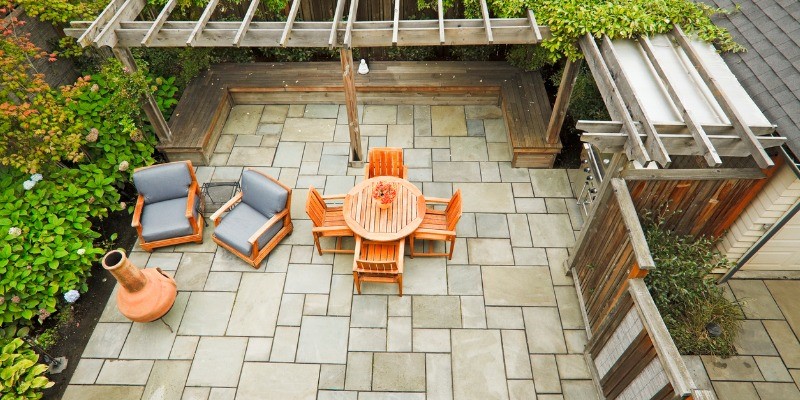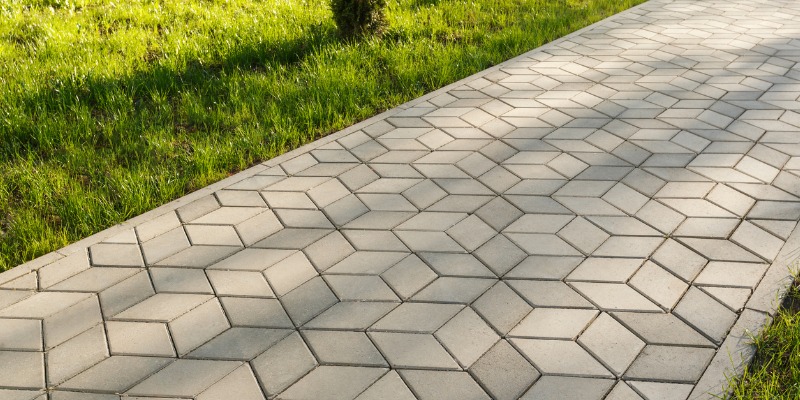The Complete Guide to Cleaning & Sealing Interlock Pavers and Slabs
Have you ever seen an interlocking driveway, pathway, or other hardscaping feature that is completely out of control? There are weeds growing in the joints, the stone itself is faded or crusted with white salt. Perhaps some stones are cracked or missing altogether. How do you prevent this from happening to your own interlocking pavers or slabs? Proper cleaning and sealant are the best ways to keep or restore the quality of your hardscaping.
In this guide, we will explain how you can clean anything off your pavers and seal it to protect it from future wear. However, unfortunately, many of the DIY guides about this online are false or outdated.
Misinformation about cleaning and sealing interlocking is so rampant, that there are a few things you need to understand upfront. Pavers and slabs have pores, just like your skin. On interlocking, these pores can fill with dirt, salt, and other stains, or they can fill with sealant, which will protect them and significantly extend their lifespan. Getting better protection for your interlocking is all about maximizing how well the sealant absorbs into the material, which also means minimizing stains and efflorescence before you seal.
Here’s what you need to know about cleaning and sealing your interlock pavers and slabs.
Is Joint Stabilization Necessary?
Joint stabilization is the necessary first step in taking care of your interlocking. The joints are the sand connection between the pavers or slabs. When they are properly maintained, the joints are not vulnerable to weeds, ants, or other insects. But, left poorly maintained, the joints soon become overrun, and that dramatically reduces the quality of the hardscaping as a whole. It also significantly increases their maintenance needs. So, using a joint stabilizer like polymeric sand is a critical step in sealing your interlocking.
What is Efflorescence?
Have you noticed white deposits collecting on the surface of your interlock? Or, an overall dull look? This is efflorescence, a collection of white salt that naturally develops on every kind of concrete paver. Efflorescence happens on any cement-based material and can start to appear on the surface within the first few months of a new installation. Efflorescence will undermine the quality of your hardscaping and interfere with sealant adhesion.
You need to remove efflorescence before you seal the surface, otherwise, the salt will be trapped beneath the sealant and alter the look of your landscaping. The sealant may actually make the white of the salt stand out even more than it did before. Unfortunately, pressure washers and soap will not remove this salt. You need to clean efflorescence with a specialized cleaner designed for the purpose. These solutions can strip the salt without damaging the actual interlocking, and that gives you a much cleaner surface for sealing.
The Importance of Stain Cleaning
However, removing efflorescence isn’t the only thing you have to do before you seal. It’s also important to remove stains. Though you may have read otherwise, the sealant doesn’t hide anything. It’s like plastic wrap, it protects but it doesn’t hide. In fact, a sealer may even make stains and blemishes in the interlocking more visible.
The sealant is important to keep the interlocking in good condition, but it can’t restore or hide anything. So, it is vital that you clean any and all stains before you seal your interlocking. Otherwise, they will be permanent, kept safe from soap and cleaners beneath the sealant. Also, a sealant may not absorb as well on areas of the interlocking that are stained, because the stain clogs up the pores.
What if you have already sealed a stain into your interlocking? You can remove the sealant, lift the stain, and reseal the interlocking. However, this is an arduous process that may even harm the environment. It should only be used as a last resort.
How to Clean Interlock
Many different specialized cleaners are available to lift just about any kind of stain from your hardscaping. All you need to do is match the type of stain you have to the right cleaning product. Solutions exist for organic stains, such as those from leaves. There are also rust removers, and oil and grease products that can remove everything from motor oil to grease from your barbecue.
However, be warned that pressure washers do not work, and neither do many of the DIY solutions toted online, from baking soda to other astringent cleaners. It is always best to choose and use a product specifically designed to clean interlocking, which ensures that you won’t damage the hardscaping while you work.
How to Seal Interlock
Ideally, you would have a professional seal your interlocking early on. Professionals are best equipped to give you the best results, that will ensure your interlocking will stay low maintenance for years. Your landscaper should wait from 60 to 90 days to seal the interlocking after it is first installed to seal it. This short wait allows efflorescence to leave the pavers and will be ideal for joint stabilization purposes.
Interlock Sealing Products
When you’re sealing your hardscaping for the first time, you have a wide choice of interlock sealing products. There are solvent-based sealants and water-based sealants. In general, you will want to rely on the expertise of your stone professional to pick the right product.
What about for second or third sealant applications? If you originally used a solvent-based sealant, you cannot use a water-based sealant after, it just won’t work. If you don’t know what kind of sealant you currently have on your interlocking, you can find out by testing it using Xylene. Or your landscaping contractors can test it for you and tell you which product you need to use.
The Process of Sealing Interlock
Here are the steps you can expect your professional to use to seal your interlocking. They should only attempt the job on a moderately cool and dry day, as extreme heat and moisture can harm the sealant.
- Choose your tools: Professionals can use a roller or sprayer to apply the sealant. This is not a typical paint roller, but one specifically designed to work with either water or solvent-based sealants.
- Apply thickly: The sealant needs to be rolled on thickly. They should do this as consistently as possible, to avoid streaks and marks from the uneven application. These can be corrected later, but it is more convenient to get the sealant right the first time.
- Wait for five minutes: Within five minutes of the first coat, the sealant should absorb into the interlocking. All you need to do is wait.
- Repeat the process: The goal is to add sealant until the interlocking cannot absorb any more, so your professionals will apply several more layers of sealant, waiting in between each, to see that it absorbs completely.
- Backroll: Eventually, the interlocking will stop absorbing the sealant. The excess must then be back rolled to finish the seal.
Many homeowners ask if they can add more sealant to better protect their interlocking. Unfortunately, the answer is no. A sealant is not like paint; you cannot add a second layer. Adding more sealant than can be absorbed into the interlocking can cause delamination. This can make your hardscaping look dusty or whitish and can negatively impact its lifespan.
How Often to Seal Interlocking?
Online advice is also often incorrect about how often you need to care for your interlocking. Assuming that your first seal was applied properly, you do not need to reseal pavers annually. Instead, it is more likely that you will need to reseal every three to five years. Often, homeowners want to reseal because they notice efflorescence or staining, but resealing does not help these problems. As we noted above, you need specialized cleaning solutions to handle these problems.
Although, you may reseal the interlocking if you strip the old layer first. You can even change to a water-based or solvent-based sealant if you’re willing to strip all of the old sealants. However, this is a long and challenging process. It should only be a last resort.
What happens if you do seal the interlocking too often? Resealing can result in delamination, faded pavers, and other problems. If you suspect that your interlocking needs to be resealed, it’s a good idea to reach out to your interlocking professional.
Keeping your interlocking pavers and concrete slabs cleaned and sealed helps you enjoy their beauty throughout the years. For all of your interlocking paver needs contact the experts at Grand River Natural Stone.

